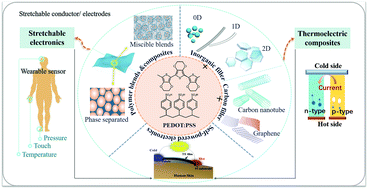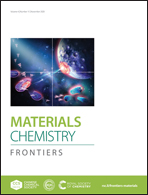Recent progress on PEDOT:PSS based polymer blends and composites for flexible electronics and thermoelectric devices
Abstract
With the development of flexible electronic devices such as organic electrodes, medical sensors and light-emitting diodes, the conductive polymer, poly(3,4-ethylenedioxythiophene):poly(styrenesulfonate) (PEDOT:PSS), has attracted tremendous research attention due to its unique properties, such as flexibility, high electrical conductivity, promising thermoelectric properties and good water processability. Over the past few years, PEDOT:PSS has been extensively investigated and many research studies have been devoted to optimizing these versatile properties via molecular or structural design. Incorporating various polymers and fillers into PEDOT:PSS through blending and mixing is the most commonly used method to modify different properties of such conductive polymers, but a related review paper is still missing, especially on stretchable electronics and thermoelectric applications. Thus, this paper reviews recent progress on PEDOT:PSS based blends and composites used in the above two applications fields. Recent studies are divided into studies on miscible polymer blends, immiscible polymer blends, inorganic filler/polymer composites and carbon filler/polymer composites. The main focus is on the electrical conductivity, stretchability and thermoelectric properties of these blends and composites based on PEDOT:PSS. It is demonstrated that careful attention needs to be paid on the structure of these blends and composites to achieve desired properties. In these PEDOT:PSS based blends and composites, the distribution of polymers and fillers within PEDOT:PSS, and the composition and configuration of PEDOT:PSS itself are governed by the interfacial interaction, processing and post-treatment methods. It is widely demonstrated that various properties, such as electrical, thermoelectric and mechanical properties, of PEDOT:PSS blends and composites could be systematically adjusted through careful design of the above aspects in these materials. Nevertheless, there are still a number of issues that need to be further investigated to expand the application of PEDOT:PSS based materials, such as constructing hierarchical structures or nano confined PEDOT:PSS in an elastic matrix to form conductive pathways with a better balance between electrical conductivity and stretchability; filler distribution, interfacial interaction and orientation of the filler should be taken into account to optimize the thermoelectric properties of PEDOT:PSS based composites; self-powered flexible wearable electronics using PEDOT:PSS composites or blends based on the Seebeck effect is still in its infancy and needs much more attention.

- This article is part of the themed collection: 2020 Materials Chemistry Frontiers Review-type Articles


 Please wait while we load your content...
Please wait while we load your content...